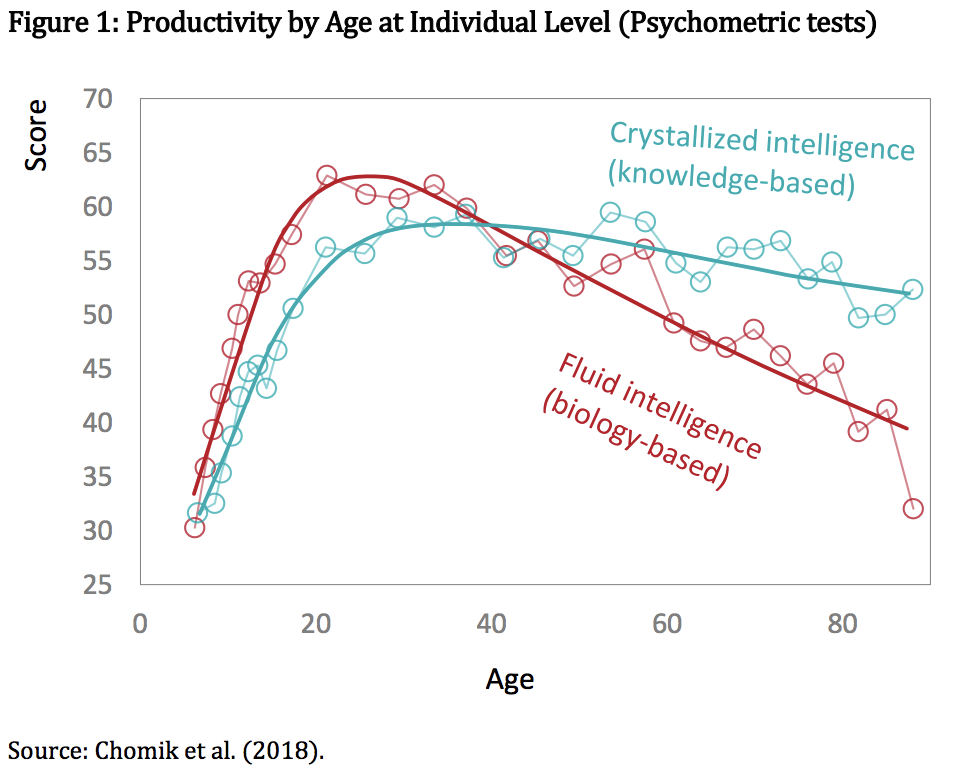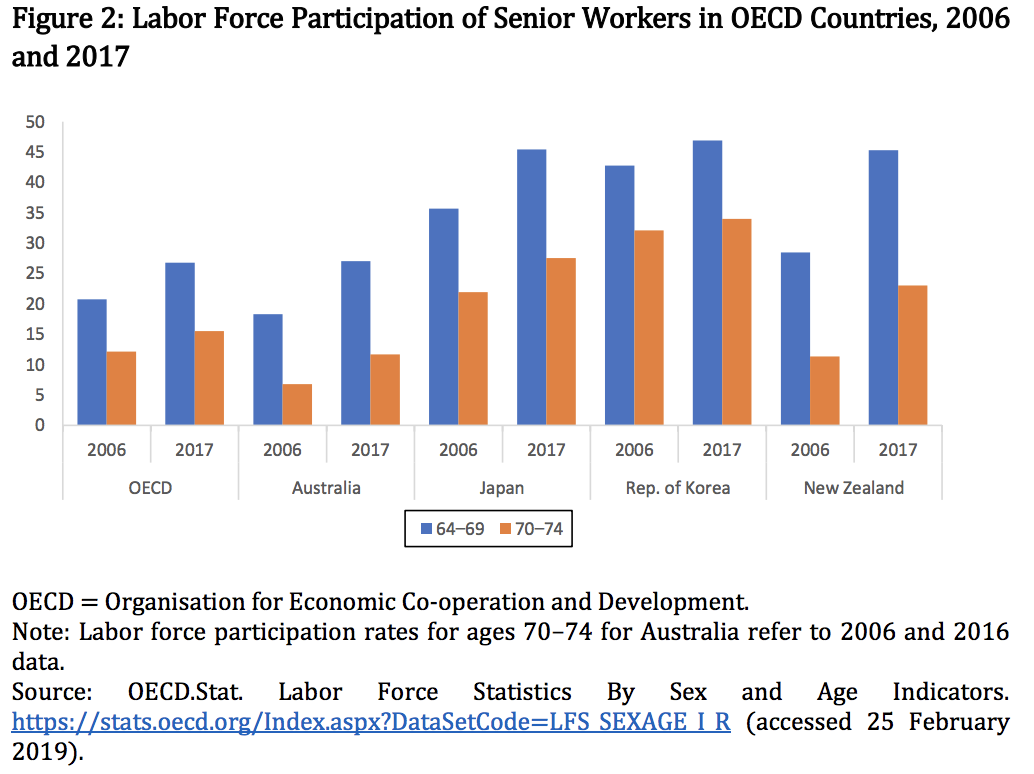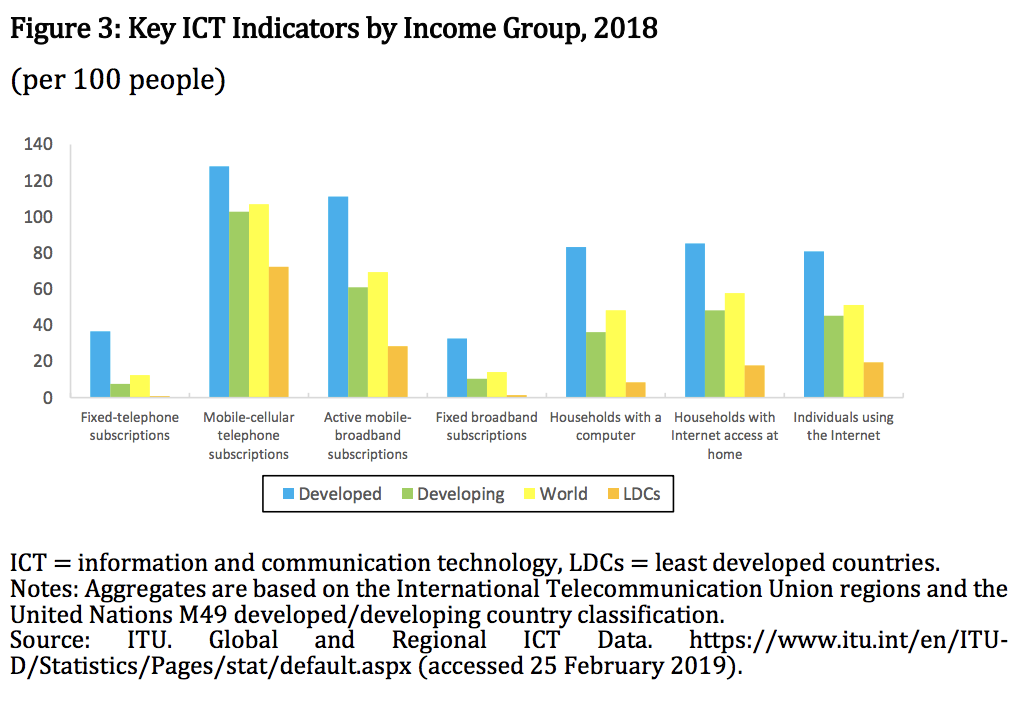Rapid technological innovations are transforming the world of work. In many G20 countries, employment is shifting towards jobs that require high-level cognitive and socio-emotional skills, while highly routine jobs are being automated or offshored to varying degrees. Today’s skills will not match tomorrow’s jobs and newly acquired skills may quickly become obsolete. As the concept of future jobs and careers becomes increasingly fluid, more emphasis will be on lifelong learning to keep up with changes in technology and maintain flexibility in skills. This brief discusses policy options for lifelong learning, target groups, and education in information and communication technology.
Challenge
Rapid technological innovations are creating new opportunities for businesses and workers while greater interaction between humans and machines will raise productivity. New technologies are also generating skills gaps and digital divides, in that, as new technology increases demand for high skills in complex jobs, it may reduce labor demand or “deskill” workers in low-skill and routine jobs.
Emerging digital age leads to a major rethinking of education and skills training. Challenges are mainly threefold:
First, human capital will depreciate at a much faster rate as new technologies transform work and the needed skills. The age-productivity profile is shown to have an inverted-U shape, as productivity starts to decline after peaking at specific ages (Figure 1). Technologies will likely increase the pace of skills depreciation and therefore lead to a faster decline of productivity after the peak (Bartel and Sicherman 1993; Lovasz and Rigó 2013). Combined with increased life expectancy, workers will face a longer period of lowered productivity in the later stage of their careers. Along with changing demographics, an increasing number of seniors above the conventional retirement age of 65 are still employed in Organisation for Economic Co-operation and Development (OECD) countries (Figure 2). Average labor force participation of OECD seniors aged 65–69 increased from 20% in 2006 to 26% in 2016 and from 12% to 15% for seniors aged 70–75.

Second, new technologies have tendencies to polarize jobs. While technology can free workers from arduous labor, technology or automation processes can also render that labor superfluous, ultimately alienating workers and stunting their development. Traditional education and training has largely focused on cognitive abilities and skills. But middle-skill, routine jobs face the highest risk of replacement by automation and new technologies. Rather than basic cognitive skills, humans will need to acquire soft and noncognitive skills, such as creativity, emotional intelligence, and complex human interactions. There will be also significant reallocation of jobs in coming years, creating more desperate need for job-training programs.

Third, while digital technologies offer vast economic potential, the value of digitization can only materialize when businesses and people have access to it. Key ICT indicators show a considerable digital divide by income level (Figure 3). The digital divide is also pronounced within most communities, disproportionately more concentrated in rural, low income, elderly, illiterate, and female. However, access to the technology alone is not enough; even where a large majority of the population has access, digital literacy and skills needed to capture economic gains are often limited and vary across segments of society.

Proposal
1. Adopt a holistic approach towards lifelong learning that encompasses all stages of life, from preschool to post-retirement, and all forms of learning, including formal, nonformal, and informal education
The skill base of the population (including education, digital skills, and ability to learn and relearn) becomes crucial for technology adoption and spread of digital jobs. The right skill mix for future jobs would include strong general cognitive skills, including literacy and numeracy, basic information and communication technology (ICT) skills, analytical skills, and a range of complementary skills like creativity, problem-solving, and critical thinking. Interpersonal and communication skills, as well as emotional skills, such as selfawareness and the ability to manage stress and change, are also increasingly important. Yet the workforce readiness varies in the adoption of new technologies and digital jobs.
As labor markets and demand for skills evolve, a comprehensive, peoplecentered, and rights-based approach to lifelong learning should help workers adjust to change, preventing the high social costs of the complex and disruptive changes ahead and maximizing their positive effects.
• Formal education: Formal education systems need to be transformed to provide learning for the changed nature of work and workplace. Policymakers working with education providers (traditional and nontraditional) could do more to improve basic science, technology, engineering, and mathematics (STEM) skills through the school systems, put a new emphasis on creativity as well as critical and systems thinking, and foster adaptive and lifelong learning.
• Nonformal education: Policymakers need to create incentives for the private sector to drive and invest in human capital development and training. The workers in increasingly ICT intensive job environments that have lower ICT skills will benefit from employers and communities willing to invest in training and upskilling. Companies need to assume a more active role in education and training, including providing better information about needs to learners and the education and training ecosystem, and providing better learning opportunities themselves. Through tax benefits and other incentives, policymakers can encourage companies to invest in human capital, including job creation, learning and capability building, and wage growth.
2. Target groups most affected by skills displacement (1)
Aging workers: Age-friendly policies will become increasingly important. Older workers are disproportionately impacted by the adoption of ICT in maintaining or getting a job that requires ICT skills. But older workers are less likely to have access to skills development than younger workers and are less likely to engage with learning if the opportunities are available to them (Meyers et al. 2010). This is because either the returns are considered too low given their remaining working careers or because the type of training delivery (e.g., in a classroom) is not attractive (OECD 2006).
Ensuring the participation of mature workers in training may be best addressed by continuing to provide them with opportunities for rich work and further development to sustain their capacities and interest in contributing to work and workplaces as well as ensuring that they have good training opportunities earlier in their careers (Dymock et al. 2012).
Low-skilled, own-account workers and small and medium-sized enterprises (SMEs), and women: Workers in SMEs and own-account workers, such as the self-employed, are under-represented in training. Women make up a disproportionaly large share in these groups as well. Greater participation of such groups can be achieved by redesigning tax systems to encourage adult learning and by providing financial support to alleviate the costs of learning. It could also mean improving systems for career guidance and opportunities for the recognition of skills acquired through informal and nonformal learning. For small firms, targeted initiatives to encourage skill needs assessment and training provision are also important measures to reach low-skilled and ownaccount workers.
In most OECD countries, low-skilled adults are less likely to participate in training, and employers and worker representatives have a key role to play in mobilizing them. Where training programs target low-skilled workers, lowskilled learners achieve the most significant outcomes, with over two-thirds of learners with no previous qualification moving to a higher qualification level (Stuart et al. 2016). The validation or recognition of nonformal and informal learning improves skill matching in the labor market by strengthening the signalling power of skills and making it easier for employers to identify which skills jobseekers already have. It also provides an incentive for individuals to further invest in learning by allowing them to capitalize on the skills they already have. This process of recognition of prior learning is particularly important in countries with high levels of under-qualification, where workers possess skills required for the job but lack a qualification to prove this.
Youth: The International Labour Organization’s (ILO) 2017 youth and future of work survey found that young workers are aware of the need for training as jobs change due to the impact of technology (ILO 2017). However, as much of the responsibility for equipping youth with relevant skills lies with national education and training systems, these systems will need to strengthen the program and services offered to ensure that initial education and training provides relevant and high-quality skills to smooth the school-to-work transition of young people. This engagement should also be broadened to offer interdisciplinary training that allows students to develop core work skills and knowledge through experiential learning, such as through quality apprenticeships and other forms of work-based learning.
Programs will increasingly need to cover a range of subjects beyond narrow occupational classifications to deliver more fluid transdisciplinary skill sets, such as those defined as 21st-century skills (Brewer and Comyn 2015). However, research by the ILO and UNESCO suggests that many technical and vocational education and training and skills systems may not as yet sufficiently support the development of these generic or so-called “soft skills” (UNESCO 2015; ILO 2015). This reinforces the need to ensure that initial education and training for young people delivers relevant skills to a high standard.
3. Invest in early childhood for the digital age
Evidence is accumulating of the positive effect of early childhood education. The rate of return to early childhood education is highest for educating children aged 0–5 according to scientific research. Early investments are potentially more valuable than those made later in adulthood (Heckman 2011 and Heckman et al. 2013, 2014, 2016 and 2018). Early childhood education also makes cognitive skills acquired by investments in human capital, even in the later stages of life, more productive. Therefore, early childhood investment can be very cost-effective.
Digital literacy and coding are important new area where early childhood education need to incorporate more actively. While building basic digital literacy, technology can be used as a tool to build skills in other areas, including reading and writing, motor skills, and socio-emotional skills.
Integrating ICT in early childhood education is particularly important to narrow the digital divide in society. Parents of low-income families are less likely to afford ICT devices and applications and are often not very familiar with the technologies themselves. Low-income families often do not own a computer or have internet access. A US study (2) finds that only about one-third of lowerincome parents have downloaded educational software for their children, whereas three-quarters of higher-income parents have done so.
Improving quality of teachers should be a priority in education policy. The results of earlier studies also indicate that school resources beyond some minimum levels are not effective, but teacher quality matters (Angrist and Lavy 1999; Rivkin, Hanushek, and Kain 2005). As digital technologies become increasingly integrated into early childhood education, the role of teachers for children of low-income families will become even more important. Early childhood education providers need to work closely with families to support the learning of young children, with a particular focus on supporting parents of low-income children. To ensure that all families are prepared to support children, early childhood providers can supplement devices and software owned by the family and open up opportunities for parental participation through digital means. In addition, teachers can model effective technology use to ensure that parents are equipped to provide support in the home. A teacher’s ability to properly facilitate technology use has also been shown to be an important determinant in whether technology leads to positive impacts on learning.
Educational expenditures should be spent wisely, particularly targeting improvement in teacher quality. This can be accomplished by maintaining high standards of curriculum design and teacher performance and recognizing the significance of retraining and regularly assessing educators.
References
• Angrist, Joshua, and Victor Lavy. 1999. “Using Maimonides’ Rule to Estimate the Effect of Class Size on Student Achievement.” The Quarterly Journal of Economics 114 (2): 533–575.
• Bartel, Ann, and Nachum Sicherman. 1993. “Technological Change and Retirement Decisions of Older Workers.” Journal of Labor Economics 11(1): 162–83.
• Brewer, Laura, and Comyn, Paul. 2015. “Integrating Core Work Skills in TVET Systems: Six Country Case Studies.” Geneva: ILO. • Chomik, Rafal, Simon Graham, Roderick Gawthorp, and Kaarin Anstey. 2018. “Cognitive Ageing and Decline: Insights from Recent Research.” Australian Research Council, Centre of Excellence in Population Ageing Research. Sydney.
• Dymock, Darryl, Stephen Billett, Helen Klieve, and Gregory Martin. 2012. “Mature Age White-Collar Workers Training and Employability.” International Journal of Lifelong Education 31(2) 171-186.
• Heckman, James. 2011. “The Economics of Inequality: The Value of Early Childhood Education.” American Educator Spring:31–47.
• _____, Rodrigo, Pinto and Peter Savelyev. 2013. “Understanding the Mechanisms through Which an Influential Early Childhood Program Boosted Adult Outcomes.” American Economic Review 103(6): 2052–2086.
• _____, Frances Campbell, Gabriella Conti, Seong Hyeok Moon, Elizabeth Pungello, Rodrigo Pinto, and Yi Pan. 2014. “Early Childhood Investments Substantially Boost Adult Health.” Science 343(6178): 1478–1485.
• _____, Paul Gertler, Rodrigo Pinto, Arianna Zanolini, Christel Vermeerch, Susan Walker, Susan Chang, Sally Grantham-McGregor. 2014 “Labor Market Returns to an Early Childhood Stimulation Intervention in Jamaica.” Science. 344(6187): 998-1001.
• _____, Sneha Elango, Andres Hojman and Jose Luis Garcia. “Early Childhood Education.” 2016. In Economics of Means-Tested Transfer Programs in the United States Volume 2, R. Moffitt (Ed.).
• _____, Gabriella Conti and Rodgrigo Pinto. 2016. “The Effects of Two Influential Early Childhood Interventions on Health and Healthy Behaviors.” Economic Journal 126(Feature Issue): F28-F65.
• _____, Jose Luis Garcia and Anna Ziff. 2018. “Gender Differences in the Benefits of an Influential Early Childhood Program.” European Economic Review, 109(October): 9– 22.
• International Labor Organization (ILO). 2015. “Enhancing Your Employability What? Why? And How? Guide to Core Work Skills.” Geneva: ILO.
• ____. 2017. Global Employment Trends for Youth 2017. Geneva: ILO.
• ____. 2019. Work for a Brighter Future. Report from the Global Commission on the Future of Work. Geneva: ILO.
• Lovasz, Anna and Mariann Rigó. 2013. “Vintage Effects, Aging and Productivity.” Labour Economics 22 (C): 47–60.
• Meyers, Rebecca, Stephen Billet, and Ann Kelly. 2010. “Mature Aged Workers Learning Needs and Motivations for Participation in Training Programs.” International Journal of Training Research 8(2): 116-127.
• Organization for Economic Cooperation and Development (OECD). 2006. “Live Longer, Work Longer.” Paris: OECD.
• ____, and ILO. 2018. “Global Skills Trends, Training Needs and Lifelong Learning Strategies for the Future of Work.” Report prepared for the 2nd Meeting of the Employment Working Group, 11–12 June 2018, Geneva.
• RAND Corporation. 2014. Using Early Childhood Education to Bridge the Digital Divide, https://www.rand.org/content/dam/rand/pubs/perspectives/PE100/…/RAND_PE 119.pdf
• Rivkin, Steven, Eric Hanushek and John Kain. 2005. “Teachers, Schools, and Academic Achievement,” Econometrica 73(2): 417-458 03.
• Stuart, Mark, Jo Cutter, Hugh Cook, Danat Valizade, Reece Garcia and Hilary Stevens. 2016. “Evaluation of the Union Learning Fund Rounds 15-16 and Support Role of Unionlearn.” Final Report. Centre for Employment Relations Innovation and Change, University of Leeds and Marchmont Observatory, University of Exeter.
• United Nations Educational, Scientific and Cultural Organization (UNESCO). 2015. “Unleashing the Potential: Transforming Technical and Vocational Education and Training.” Paris: UNESCO.
• World Economic Forum (WEF). 2017. The Global Human Capital Report 2017: Preparing People for the Future of Work. Cologny/Geneva: WEF.








